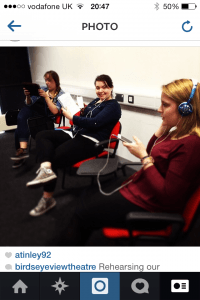In the opening line of our Manifesto, we state that Birds Eye View Theatre Company, “are committed to creating REAL theatre. Honest theatre. Truthful theatre. Theatre that uses real people’s voices.” (Company Manifesto, 2014). In Verbatim, Verbatim, Will Hammond and Dan Steward define this diverse style of theatre a simple step by step process in which; ‘The words of real people are recorded or transcribed by a dramatist during an interview by a dramatist during an interview or research process…’ (2008, p.9).
From a directorial viewpoint, working with verbatim or devising theatre so both are new challenges for me as I have only ever worked with adaptions and script based texts before. Having watched Ours Was The Fen Country directed by previous DV8 member Dan Canham, we decided upon a similar style using head phones to listen to the verbatim as we spoke it. A few weeks ago, our producer Jess made contact with Mr Canham to ask some vital tips when learning verbatim. One of the best tips that Canham gave us was to listen to the piece as if it were a rhythm. We grasped the ways in which we could project the verbatim from watching the show. For the actors in the Ours Was The Fen Country, this was facing the audience head on and speaking the words. This may sound incredibly simple I have learned the key to creating verbatim which will evoke emotion is to set the scene using the words, images and background movements can then be added separately. Watch a snippet of verbatim practise below…
This brings me to my favorite Birds Eye View rehearsal so far which took place on Tuesday 18th March. We managed to pull together 16 minutes of our show for our work in progress showing, and most importantly I was able to work with each actor individually on their verbatim section. In terms of rhythm, Jennie’s appears to be the fastest, Her verbatim was taken from Charlotte and Ellie’s visit to one of our two care homes. Listening to the piece along side Jennie we were able to notice moments in which we could create beats in the dialogue, similar to the beats an actor would use to mark a fresh script.
Katie Mitchell’s book, The Directors Craft was equally as useful for developing the characters immediate circumstances. By this I mean simple things which the actor can imagine to help them pick out more of the character, Mitchell defines immediate circumstances as; ‘…the events that happen in the 24 hours or so leading up to the action in the scene.’ (Mitchell, 2009, p.31). Using verbatims from both Louise’s and Lauren’s Grandmas, these details became things such as how the furniture was set in the room, what was playing on the television and the time of day. For example Emily’s grandmother sips a cup of tea as she speaks, a detail which when added to the scene allows the audience to see further into the lives of our interviewees.
Works Cited:
Birds Eye View Theatre Comany (2014) Manifesto [online] Lincoln: Lincoln University Blogs. Available from: https://birdseyeviewtheatre.blogs.lincoln.ac.uk/sample-page/manifesto/ [Accessed 27 February 2014].
Hammond, W. & Dan Steward (2008) Verbatim, Verbatim London : Oberon Books.
Mitchell, K. (2009) The Director’s Craft: A Handbook for the Theatre. London and New York: Routledge.
